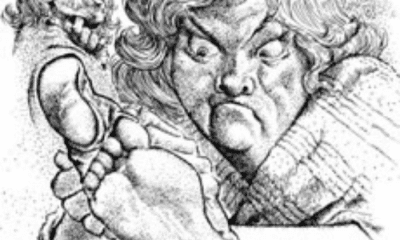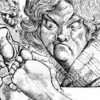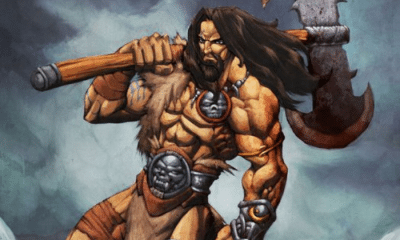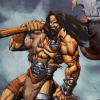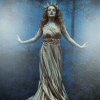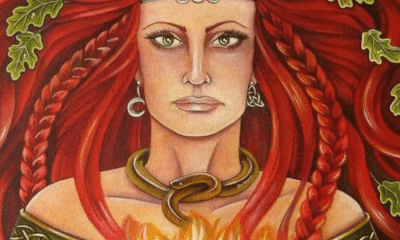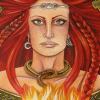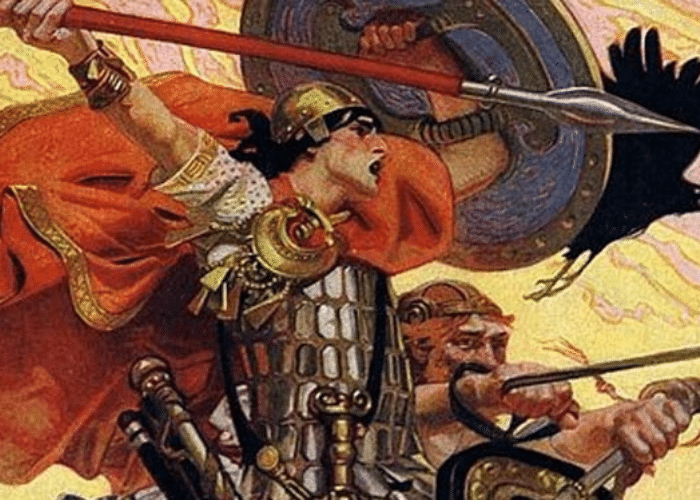
Irish
Cu Chulainn: The Great Hero of Ulster
Cu Chulainn: The Great Hero of Ulster
Cu Chulainn is one of the greatest heroes in Irish folklore. Keep reading to learn all about the hero of the Ulster Cycle!
The legends of Ireland are often split into different cycles. These correspond to both the location and time periods of specific groups of stories.
The legends of the Ulster Cycle are said to have taken place around the 1st century AD. The center around the kings and heroes of that age.
One of the most beloved of these figures is Cu Chulainn. Usually thought of as the son of one of the great warriors of the Tuatha De Dannan, Cu Chulainn was a demi-god whose strength and ferocity made him an unmatched fighter.
Cu Chulainn, however, was destined to have a short but eventful life. Like the Greek hero Achilles, he chose to pursue fame and great deeds over a quiet, peaceful old age.
One of the many factors that contributed to his downfall was the fact that Cu Chulainn made a dangerous enemy. Slights against eh Morrigan, the goddess of war and fate, all but ensured that he would eventually die in battle.
Although he only lived to be in his early twenties, Cu Chulainn accomplished more than most men ever would. His strength, willpower, and love of adventure made him a symbol of Ireland for hundreds of years.
The Birth of Cu Chulainn
Although Cu Chulainn is a well-known figure in Irish lore, few people know that Cu Chulainn was not actually his given name.
He was born with the name Setanta, or “Son of Sualtam.”
Sualtam’s status as Cu Chulainn’s father or foster father comes from the oldest known version of the legend, but the most popular version gives the hero divine parentage instead.
In the best-known version of the story, Deichtine was the sister of Conchobar, the King of Ulster. One night, she disappeared from his capital, Emain Macha, and was not seen again.
Some time later, the men of Ulster gathered to hunt a flock of magical birds. As they returned to Emain Macha, a snowstorm overtook them and they took shelter in a secluded cottage.
Their host was Lugh, a king of the Tuatha De Dannan. When they arrived, he told them that his wife was in labor.
When morning arrived, the house and Lugh had both disappeared. Lugh’s wife, however, was revealed to be Deichtine and she held her new son, Setanta.
The Ulstermen argued over who should be the boy’s foster father. Ultimately, the leading men of the kingdom decided to share the duty and each taught young Setanta a different set of valuable skills.
As a very young child, Setanta already showed exceptional strength. He entered his first battle frenzy as a young boy and struggled to control his abilities.
Setanta earned the title he was better known by at just seven years old.
Culann the smith invited Conchobar to a feast. The king asked his young nephew to accompany him, but Setanta was late coming from a game.
Conchobar forgot that he had invited the boy, so Culann set his enormous guard dog to patrol the property while they feasted.
When Setanta arrived, the hound attacked him. Armed only with the ball he had been playing with, the child killed the vicious dog by driving the ball into its throat.
While everyone was impressed at this feat, Culann was devastated to lose his hound. Setanta viewed to make amends by rearing a new guard dog himself and filling the position until the pup was ready to take up its duties.
Cathbad the druid, who was living in Culann’s hall at the time, gave the boy the title of Cu Chulainn, or “Culann’s Hound.” From that time on, the hero used the title he earned as a child instead of his given name.
While in service to Culann, Cu Chulainn heard the druid given a lesson to his students. When he asked what they had been talking about, Cathbad told him that it was an auspicious day.
Any soldier that took up weapons that day would win great renown. There was more to the lesson, but the eager boy ran off before Cathbad could tell him the rest of the lesson.
Cu Chulainn went to his uncle and asked for a set of weapons. They went through several items, but none held up under the seven-year old’s remarkable strength. Eventually, the king gave the boy his own weapons instead.
Cu Chulainn rushed back to the druid to show him that he had taken up weapons. Cathbad was not as happy as he had expected him to be, however.
The reason none of the other boys had claimed weapons yet was because the first to choose would have the most fame, but would also be doomed to die young. Cu Chulainn had ensured that he would be a great warrior, but his life would be cut short.
The Hero’s Attributes
Cu Chulainn proved by age seven that he did not need exceptional weapons to become a leading warrior.
His strength was his foremost attribute. Even as a child, he was stronger than any grown man.
As he grew, his physical prowess only became greater. In one legend, a sleeping potion strong enough to leave a common man unconscious for a full day and night put Cu Chulainn to sleep for less than an hour.
His strength was only augmented by his battle rage.
This rage, or riastrad, made him a fearsome opponent. It also made him an unreliable ally.
When overcome with battle rage, Cu Chulainn did not pay attention to reason or logic. He became so destructive that he threatened his own friends and family.
As a young man, Cu Chulainn had sought out the three sons of Nechtan Scene, who had together killed many Ulstermen in battle. He entered such a frenzy that he was still in the grips of the riastrad when he returned to Emain Macha.
Fearful that he would kill everyone there, the women of Ulster quickly put a plan in place. They ran out of the gates and exposed their breasts.
Cu Chulainn looked away to avoid seeing his foster mothers in a state of undress, which was enough of a distraction for the men of Emain Macha to grab him. They threw him into a barrel of cold water to break him out of the frenzy.
The barrel exploded from his heat, however. They threw him into a second barrel, which boiled.
Finally, the third barrel cooled him enough that Cu Chulainn came to his senses.
Cu Chulainn was also a master of many disciplines. He had learned not only warfare, but art, poetry, and law from his many foster fathers.
In addition to all these gifts, Cu Chulainn also went into battle well-armed.
Laeg, his charioteer, drove a vehicle that had been built especially to withstand the hero’s strength. It was pulled by Liath Macha and Dub Sainglend, the greatest horses the world had ever seen.
Gae Bulg, his spear, had been made from a sea monster’s bones. When it struck, it released thirty smaller barbs to cause unimaginable pain.
Armed with these great attributes, Cu Chulainn was almost unstoppable in battle. His most famous fight, in fact, took place when he was only a teenager.
Cu Chulainn in the Cattle Raid
Medb, the Queen of Connacht, was often at odds with her neighbors. Following a feud with her estranged husband, she decided to steal a prized bull from the herds of Ulster to best his greatest bull.
Cu Chulainn was seventeen years old at the time and had been put on duty guarding the border. Distracted by a girl, however, he had allowed Medb’s raiding party to slip past him in the night.
As the men of Ulster prepared to fight back against these invaders, they were struck by a curse. All of them experienced such terrible pains that they could barely move or stand.
Only Cu Chulainn, with his exceptional constitution, could shrug off the pain. It fell to him to defend Ulster from the queen’s men.
He marched out alone and demanded the right to single combat. Medb sent champion after champion to fight him, but each was defeated.
According to some, the standoff lasted for months. Cu Chulainn bested every warrior Connacht sent against him without a break.
Finally, Medb stopped sending men to fight him. Although the armies of Connacht were still there, Cu Chulainn took the break happily.
A beautiful young woman approached him as he drank from a stream. Saying that she was the daughter of a king, she offered the young hero her love.
Cu Chulainn refused her, though. Angry, she revealed herself to be the Morrigan, the goddess of war, and vowed that she would not forgive his slight.
In his next fight, the Morrigan appeared in animal form to attack him. Forced to fight off both his human opponent and these beasts, he struggled for the first time.
First, the Morrigan appeared as an eel to trip him as he crossed a ford. He kicked her away, breaking her ribs.
Then she came as a wolf, sending a herd of cattle stampeding toward him. He blinded her with a slingshot, however.
Finally, the Morrigan appeared as a heifer at the head of the stampede. With another stone from his slingshot, he broke her leg and turned back to defeat his human opponent.
After the fight, a crippled old woman approached him with a cow.
Cuchulain, maddened with thirst, begged her for a milking. She gave him a milking of one of the teats. “May this be a cure in time for me, old crone,” quoth Cuchulain, and one of the queen’s eyes became whole thereby. He begged the milking of another teat. She milked the cow’s second teat and gave it to him and he said, “May she straightway be sound that gave it.” [Then her head was healed so that it was whole.] He begged a third drink of the hag. She gave him the milking of the teat. “A blessing on thee of gods and of non-gods, O woman!” [And her leg was made whole thereby.] Now these were their gods, the mighty folk: and these were their non-gods, the folk of husbandry. And the queen was healed forthwith.
-Tain Bo Cualnge (The Cattle Raid of Cooley), trans Dunn
With each drink, Cu Culainn had blessed the old woman. Actually the Morrigan in disguise, the blessings healed the wounds he had caused her.
When he learned this, Cu Chulainn swore that if he had known who she was he would never have offered such blessings. The Morrigan swore that she would soon see his death.
Eventually, Medb sent an enemy against him that he could not fight.
Fergus mac Roich lived in Connacht as an exile but had once been a man of Ulster. He was one of Cu Chulainn’s foster fathers and had taught him about honor and charity.
Cu Chulainn could not bear to fight his foster father and kill him. He agreed to yield as long as Fergus agreed to do the same the next time they met.
Exhausted, Cu Chulainn fell asleep after standing down the fight. He did not know, however, that the trainee boys of Ulster had decided to charge the enemy.
Lugh appeared to Cu Chulainn as he slept. The god healed his many wounds and revealed that he was Cu Chulainn’s father.
When he awoke, Cu Chulainn felt refreshed. He was horrified, however, when he learned that the boys of Ulster had been slaughtered as he slept.
With them had been his foster brother and best friend, Ferdiad.
Cu Chulainn flew into the greatest rage he had ever experienced. When he came to his sentences, the bodies of a hundred men were piled in a wall around him.
Eventually, the armies of Ulster began to recover from the effects of the curse. They took to the field, allowing Cu Chulainn to finally rest.
The hero was happy to sit on the sidelines and recoup from his grueling battles. He ran onto the field, however, when he saw the leader of Medb’s army.
The queen had made Fergus mac Roich her commander. Cu Chulainn ran to the front of Ulster’s army and met his foster father in battle again.
He reminded Fergus of his vow to yield the next time they met. Fergus had no choice but to order his men to stand down and end the battle.
Connacht’s allies panicked when they saw this a fled from the field as well. Cu Chulainn chose to spare Queen Medb because Fergus had once taught him that it was wrong to kill women.
The Hero’s Family
Cu Chulainn would not kill a woman in battle, but they played another role in many of his legends.
The hero was said to have been impossibly handsome, although sources do not agree on what he looked like. He was said to be so attractive, however, that his family sent him away as a teenager because the lords of Ulster feared their wives and daughters would be tempted by his beauty.
Cu Chulainn himself, however, only desired one woman. He had always loved Emer and his father said that he could marry her if he studied under the greatest fighter in Scotland.
Cu Chulainn was sent to Scotland where he had the first of his many affairs. Under the tutelage of Scathach, a warrior woman from the Isle of Skye, he met Aife.
Aife and Scathach were rivals. When Aife came to issue a challenge, Scathach attempted to drug Cu Culainn to keep him away from the dangerous fight.
He quickly shook off the effects of the sleeping potion, however, and jumped in to help his mentor. He bested Aife only by tricking her into looking away for a moment, but spared her life on the condition she call off her feud with Scathach.
He and Aife became lovers, but he soon returned home to Ulster. There, he sought approval to marry the girl he had once sworn eternal love for, Emer.
Emer’s father opposed the match, however, and refused to let Cu Chulainn even see his daughter. Enraged, Cu Chulainn stormed his keep and killed twenty four of his men before abducting Emer.
Cu Chulainn married the woman he loved, but he was not always faithful to her. Various legends claimed that he had many other lovers. They included:
- Bathnat – In disguise, Cu Roi mac Daire of Munster joined the men of Ulster on a raid and tried to claim Bathnat as his share of the spoils. She loved Cu Chulainn, however, and told him how to kill her abductor. He succeeded, but Cu Roi’s poet grabbed Bathnat and lept from a cliff, killing them both.
- Debforgaill – Cu Chulainn rescued the Scandinavian princess from being sacrificed to the Fomorians.Having tasted her blood by sucking a stone from her side, he could not marry her himself so he had her wed to his foster son, the future High King Lugaid.
- Fand – The fae goddess agreed to marry Cu Chulainn in exchange for help against the Formorians. Emer was jealous of her but eventually relented because she saw the power of their love. Moved by Emer’s grace, Fand returned to the sidhe and never saw Cu Chulainn again.
The only child named consistently in Cu Chulainn’s legends, however, is Connla.
Several years after his marriage to Emer, a young man appeared at Cu Chulainn’s home. When he refused to identify himself, Cu Chulainn assumed he was an intruder and attacked him.
Having wounded the young man, Cu Chulainn got close enough to see the ring on the boy’s finger. It identified him as Aife’s son.
The warrior woman had been furious that Cu Chulainn had loved another woman after leaving her behind. In revenge, she had set her own son up to torment him.
Aife had told Connla to never identify himself or back down from a battle. She did this known that Cu Chulainn would attack him if he didn’t know who he was.
Aife’s son was skilled with a spear and had been taught to fight against Cu Chulainn’s battle frenzy. Connla, however, had been unwilling to fight back when he realized the Cu Chulainn was his father.
Connla’s last words before he died in his father’s arms were that the two of them together could have taken the flag of Ulster to the gates of Rome with their power.
The Death of Cu Chulainn
Cu Chulainn was a hero in Ulster, but elsewhere he had made many enemies. One of these knew his greatest weakness.
Cu Chulainn was bound by two geas, or magical oaths. To break a geas resulted, usually, in death.
The first was that he was not allowed to refuse any food offered to him by a woman. The second was the Cu Chulainn was not allowed to eat any food meant for a dog.
One day, a woman invited him into her home. She offered him meat that had been cut for her dog.
Cu Chulainn could not refuse the offer, so he ate the food that had been offered to him. His strength immediately began to wane because he had broken a geas.
Soon after, his other enemies began to converge. Queen Medb’s armies were once again marching into Ulster.
On his way to the battlefield, Cu Chulainn met the same woman who had fed him not long before. She stood in a stream, washing armor identical to his that was covered in blood.
Cu Chulainn realized then that she was the Morrigan. In forcing him to break his geas, she had fulfilled her vow that she would see his death.
Cu Roi’s son, a different Lugaid than Cu Chulainn’s foster son, had joined with Medb to avenge his father. With the aid of the Morrigan, he threw three spears in the first moments of the battle.
The first hit Laeg, the charioteer, and killed him instantly. The second struck Liath Macha, the King of Horses.
The third went through Cu Chulainn’s stomach.
The hero, however, refused to die in the dirt. He pulled himself up against a standing stone and tied himself to it so he would not fall down again.
Cu Chulainn raised his sword in defiance and his reputation was so great that no man came near for a killing blow. Only when a raven, the Morrigan’s bird, landed on his shoulder to signal his death did Lugaid come close.
Lugaid tried to claim the hero’s head, but a light flashed as he did so. Cu Chulainn’s arm fell and, in a final act of strength, cut off Lugaid’s hand.
Ulster ultimately won the battle, but it lost its greatest hero.
A Symbol of Ireland
Beginning in the late 19th century, the Gaelic revival movement led to a renewed interest in the Irish language and cultural identity.
One of the leading voices in this movement was Lady Augusta Gregory, a folklorist a dramatist. Drawing off Irish legends and mythology, she rewrote the stories to be accessible to a generation of English speakers who were largely unfamiliar with them.
Cu Chulainn was one of her favorite figures. Her works helped to make the hero of the Ulster legends popular throughout Ireland.
By the early 20th century, Cu Chulainn was a popular figure in the growing Irish nationalist movement. He became a symbol of strength and courage that all Irish people could admire.
After the Easter Rising in 1916, Cu Chulainn’s symbolism became even more potent. His likeness was used in later years to commemorate the event.
Nationalists embraced Cu Chulainn as a symbol of courage and determination, but the unionists of Ulster also used him in their own imagery.
To them, Cu Chulainn was a hero who fought against invaders from the south. His enemies were not foreigners, but Irish forces from outside of Ulster’s borders.
Throughout the 20th century, Cu Chulainn’s legend was used to bolster the morale and symbolize the strength of both sides of the conflict in Ireland.
Today, Cu Chulainn’s story is referenced for its emphasis on love and honor as well as physical strength. Artwork from the 21st century shows, for example, the feats he accomplished to win Emer’s hand and his grief over the death of Ferdiad.
For many years, the image of Cu Chulainn was used in the spirit of conflict. In recent years, however, it has been one of the resilience, romanticism, and endurance of the Irish people.
Cu Chulainn the Hero
Cu Chulainn is the central hero of the Ulster Cycle, a series of northern Irish legends said to have taken place in roughly the 1st century AD.
Although the stories of his birth vary, one popular account is that he was a son of the warrior god Lugh. Raised as a foster son of all the lords of Ulster, he learned different skills from each.
By age seven, Cu Chulainn had earned a reputation as a skilled fighter. He had also sealed his doom, however, by inadvertently triggering a curse that meant he would achieve great fame but die young.
By age seventeen, Cu Chulainn was the most skilled warrior in Ireland. When the rest of the Ulstermen were struck by an illness, he defeated every warrior of Connacht in single combat for months until they were recovered.
The only man he did not beat was Fergus, one of his foster fathers, who he refused to fight. He invoked their promises to one another, however, to make Fergus and his army abandon the battle altogether.
During the famous Cattle Raid of Cooley, however, he made a dangerous enemy. He insulted the Morrigan, the goddess of war and fate, who swore that she would witness his death.
In the course of his short life, Cu Chulainn had many adventures and led Ulster to great victories. He also experienced tragic losses, such as the inadvertent killing of his own unknown son.
When he died in battle, in large part due to the Morrigan’s machinations, he tied himself to a standing stone so he could die on his feet. These acts of courage and defiance made him a powerful symbol of Irish pride throughout the 19th and 20the centuries.


